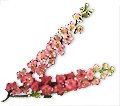|
Funeral Flowers
|
 |
|
|
chrysanthemums, carnations -
Australia |
   |
|
Funeral Flowers
|
 |
|
|
chrysanthemums, carnations -
Australia |
   |
Not gold, not blood, their altar dowers,
But votive tears and symbol flowers.
PB Shelley, Hellas
Papyrus of Ani
RUBRIC (From the Papyrus of Nu): [This Chapter] shall be recited over a Tet of gold set in a stand made of sycamore wood which hath been steeped in a tincture of ankhamu flowers, and it shall be placed on the neck of the deceased on the day of the funeral.
At the gravesites family members engage in sprucing up the gravesite, decorating it with flowers, setting out and enjoying a picnic, and interacting socially with other family and community members who gather at the cemetery.
In Japan, for instance, white flowers and chrysanthemums are
symbols of death;
The third symbolic element is the flower [ka], with Japanese
artists being especially fond of cherry and plum blossoms. Flowers are symbols
of life: "Wherever they appear, flowers, and plants in general, are usually
depicted in there natural, wild, unadulterated state. In Japan, however,
flowers, grasses, and trees are not viewed merely as tangible objects, but as
symbols of otherwise intangible phenomena -- of life itself. In flowers we
perceive the universal laws of nature, the unending cycle of life: birth, death,
rebirth" (Kurita).
Now, ballad, gather poppies in thine hands
And sheaves of brier and many rusted sheaves
Rain-rotten in rank lands,
Waste marigold and late unhappy leaves
And grass that fades ere any of it be mown;
And when thy bosom is filled full thereof
Seek out Death's face ere the light altereth,
And say "My master that was thrall to Love
Is become thrall to Death."
Algernon Charles Swinburne, A Ballad of Death